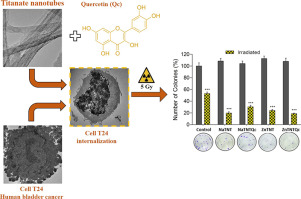Biomaterials Advances ( IF 5.5 ) Pub Date : 2020-01-15 , DOI: 10.1016/j.msec.2020.110662 Luisa Alban , Wesley Formentin Monteiro , Fernando Mendonça Diz , Gabriela Messias Miranda , Carolina Majolo Scheid , Eduardo Rosa Zotti , Fernanda Bueno Morrone , Rosane Ligabue

|
Interest in nanostructures such as titanate nanotubes (TNT) has grown notably in recent years due to their biocompatibility and economic viability, making them promising for application in the biomedical field. Quercetin (Qc) has shown great potential as a chemopreventive agent and has been widely studied for the treatment of diseases such as bladder cancer. Motivated by the possibilities of developing a new hybrid nanostructure with potential in biomedical applications, this study aimed to investigate the incorporation of quercetin in sodium (NaTNT) and zinc (ZnTNT) titanate nanotubes, and characterize the nanostructures formed. Qc release testing was also performed and cytotoxicity in Vero and T24 cell lines evaluated by the MTT assay. The effect of TNTs on T24 bladder cancer cell radiosensitivity was also assessed, using cell proliferation and a clonogenic assay. The TNT nanostructures were synthesized and characterized by FESEM, EDS, TEM, FTIR, XRD and TGA. The results showed that the nanostructures have a tubular structure and that the exchange of Na+ ions for Zn2+ and incorporation of quercetin did not alter this morphology. In addition, interaction between Zn and Qc increased the thermal stability of the nanostructures. The release test showed that maximum Qc delivery occurred after 24 h and the presence of Zn controlled its release. Biological assays indicated that the NaTNTQc and ZnTNTQc nanostructures decreased the viability of T24 cells after 48 h at high concentrations. Furthermore, the clonogenic assay showed that NaTNT, NaTNTQc, ZnTNT and ZnTNTQc combined with 5 Gy reduced the formation of polyclonal colonies of T24 cells after 48 h. The results suggest that the nanostructures synthesized in this study interfere in cell proliferation and can therefore be a powerful tool in the treatment of bladder cancer.
中文翻译:

槲皮素包覆的钛酸酯纳米管及其对人膀胱癌的放射增敏作用
近年来,由于其生物相容性和经济可行性,人们对诸如钛酸酯纳米管(TNT)等纳米结构的兴趣显着增长,使其有望在生物医学领域中得到应用。槲皮素(Qc)已显示出作为化学预防剂的巨大潜力,并且已被广泛研究用于治疗诸如膀胱癌的疾病。受开发具有生物医学应用潜力的新型杂化纳米结构的可能性的激励,本研究旨在研究槲皮素在钛酸钠(NaTNT)和锌(ZnTNT)纳米管中的掺入并表征所形成的纳米结构。还进行了Qc释放测试,并通过MTT分析评估了Vero和T24细胞系的细胞毒性。还评估了TNT对T24膀胱癌细胞放射敏感性的影响,使用细胞增殖和克隆形成测定。通过FESEM,EDS,TEM,FTIR,XRD和TGA合成并表征了TNT纳米结构。结果表明,纳米结构具有管状结构,Na的交换Zn 2+的+离子和槲皮素的掺入并没有改变这种形态。另外,Zn和Qc之间的相互作用增加了纳米结构的热稳定性。释放测试表明,最大的Qc释放在24小时后发生,并且Zn的存在控制了它的释放。生物学分析表明,NaTNTQc和ZnTNTQc纳米结构在高浓度48小时后会降低T24细胞的生存能力。此外,克隆形成试验还显示,NaTNT,NaTNTQc,ZnTNT和ZnTNTQc与5 Gy联合使用可在48 h后减少T24细胞多克隆集落的形成。结果表明,本研究中合成的纳米结构会干扰细胞增殖,因此可以成为治疗膀胱癌的有力工具。











































 京公网安备 11010802027423号
京公网安备 11010802027423号